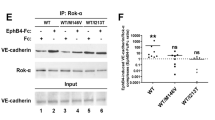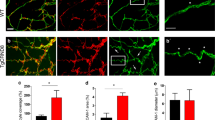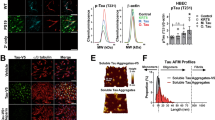Abstract
Peptides derived from proteolytic processing of the β–amyloid precursor protein (APP), including the amyloid–β peptide, are important for the pathogenesis of Alzheimer's dementia. We found that transgenic mice overexpressing APP have a profound and selective impairment in endothelium–dependent regulation of the neocortical microcirculation. Such endothelial dysfunction was not found in transgenic mice expressing both APP and superoxide dismutase–1 (SOD1) or in APP transgenics in which SOD was topically applied to the cerebral cortex. These cerebrovascular effects of peptides derived from APP processing may contribute to the alterations in cerebral blood flow and to neuronal dysfunction in Alzheimer's dementia.
This is a preview of subscription content, access via your institution
Access options
Subscribe to this journal
Receive 12 print issues and online access
$209.00 per year
only $17.42 per issue
Buy this article
- Purchase on Springer Link
- Instant access to full article PDF
Prices may be subject to local taxes which are calculated during checkout





Similar content being viewed by others
References
Lendon, C. L., Ashall, F. & Goate, A. M. Exploring the etiology of Alzheimer disease using molecular genetics. JAMA 277, 825– 831 (1997).
Mattson, M. P. Cellular actions of beta–amyloid precursor protein and its soluble and fibrillogenic derivatives. Physiol. Rev. 77, 1081–1132 (1997).
Smith, M. A. et al. Amyloid–beta deposition in Alzheimer transgenic mice is associated with oxidative stress. J. Neurochem. 70, 2212–2215 (1998).
Hensley, K. et al. A model for beta–amyloid aggregation and neurotoxicity based on free radical generation by the peptide: relevance to Alzheimer disease. Proc. Natl. Acad. Sci. USA 91, 3270– 3274 (1994).
Yan, S. D. et al. RAGE and amyloid–beta peptide neurotoxicity in Alzheimer's disease. Nature 382, 685– 691 (1996).
Behl, C., Davis, J. B., Lesley, R. & Schubert, D. Hydrogen peroxide mediates amyloid beta protein toxicity. Cell 77, 817–827 (1994).
Thomas, T., Thomas, G., McLendon, C., Sutton, T. & Mullan, M. β–amyloid–mediated vasoactivity and vascular endothelial damage. Nature 380, 168–171 (1996).
Thomas, T., McLendon, C., Sutton, E. T. & Thomas, G. Cerebrovascular endothelial dysfunction mediated by beta–amyloid. Neuroreport 8, 1387–1391 (1997).
Crawford, F., Suo, Z., Fang, C. & Mullan, M. Characteristics of the in vitro vasoactivity of beta–amyloid peptides. Exp. Neurol. 150, 159–168 ( 1998).
Blanc, E. M., Toborek, M., Mark, R. J., Hennig, B. & Mattson, M. P. Amyloid beta–peptide induces cell monolayer albumin permeability, impairs glucose transport, and induces apoptosis in vascular endothelial cells. J. Neurochem. 68, 1870–1881 (1997).
Hsiao, K. K. et al. Age–related CNS disorder and early death in transgenic FVB/N mice overexpressing Alzheimer amyloid precursor proteins. Neuron 15, 1203–1218 ( 1995).
Wong, P. C. et al. An adverse property of a familial ALS–linked SOD1 mutation causes motor neuron disease characterized by vacuolar degeneration of mitochondria. Neuron 14, 1105–1116 (1995).
Sobey, C. G. & Faraci, F. M. Effects of a novel inhibitor of guanylyl cyclase on dilator responses of mouse cerebral arterioles. Stroke 28, 837–843 ( 1997).
Rosenblum, W. I., McDonald, M. & Wormley, B. Calcium ionophore and acetylcholine dilate arterioles on the mouse brain by different mechanisms. Stroke 20, 1391–1395 (1989).
Rosenblum, W. I. Endothelial dependent relaxation demonstrated in vivo in cerebral arterioles. Stroke 17, 494–497 (1986).
Sobey, C. G., Heistad, D. D. & Faraci, F. M. Mechanisms of bradykinin–induced cerebral vasodilatation in rats. Evidence that reactive oxygen species activate K+ channels. Stroke 28, 2290–2294 ( 1997).
Mayhan, W. G. Role of activation of bradykinin B2 receptors in disruption of the blood–brain barrier during acute hypertension. Brain Res. 738, 337–341 (1996).
Rosenblum, W. I. & Nelson, G. H. Endothelium dependence of dilation of pial arterioles in mouse brain by calcium ionophore. Stroke 19, 1379–1382 (1988).
Wang, Q., Pelligrino, D. A., Koenig, H. M. & Albrecht, R. F. The role of endothelium and nitric oxide in rat arteriolar dilatory responses to CO2 in vivo. J. Cereb. Blood Flow Metab. 14, 944–951 (1994).
Faraci, F. M., Williams, J. K., Breese, K. R., Armstrong, M. L. & Heistad, D. D. Atherosclerosis potentiates constrictor responses of cerebral and ocular blood vessels to thromboxane in monkeys. Stroke 20, 242– 247 (1989).
Mayhan, W. G., Faraci, F. M. & Heistad, D. D. Responses of cerebral arterioles to adenosine 5´–diphosphate, serotonin, and the thromboxane analogue U–46619 during chronic hypertension. Hypertension 12, 556–561 (1988).
Carlson, G. A. et al. Genetic modification of the phenotypes produced by amyloid precursor protein overexpression in transgenic mice. Hum. Mol. Genet. 6, 1951–1959 ( 1997).
Hsiao, K. et al. Correlative memory deficits, Aβ elevation, and amyloid plaques in transgenic mice. Science 274, 99– 102 (1996).
Stamler, J. S. A radical vascular connection. Nature 380, 108–111 (1996).
Mohazzab, K. M., Kaminski, P. M. & Wolin, M. S. NADH oxidoreductase is a major source of superoxide anion in bovine coronary artery endothelium. Am. J. Physiol. 266, H2568–2572 (1994).
Wang, P. et al. Overexpression of human copper, zinc–superoxide dismutase (SOD1) prevents postischemic injury. Proc. Natl. Acad. Sci. USA 95, 4556–4560 ( 1998).
Yang, S. T., Mayhan, W. G., Faraci, F. M. & Heistad, D. D. Endothelium–dependent responses of cerebral blood vessels during chronic hypertension. Hypertension 17, 612– 618 (1991).
Wei, E. P., Kontos, H. A., Christman, C. W., DeWitt, D. S. & Povlishock, J. T. Superoxide generation and reversal of acetylcholine–induced cerebral arteriolar dilation after acute hypertension. Circ. Res. 57, 781– 787 (1985).
Mayhan, W. G. Impairment of endothelium–dependent dilatation of basilar artery during chronic hypertension. Am. J. Physiol. 259, H1455–1462 (1990).
Sobey, C. G., Faraci, F. M., Piegors, D. J. & Heistad, D. D. Effect of short–term regression of atherosclerosis on reactivity of carotid and retinal arteries. Stroke 27, 927–933 (1996).
Faraci, F. M. & Heistad, D. D. Regulation of the cerebral circulation: Role of endothelium and potassium channels. Physiol. Rev. 78, 53–97 (1998).
Zhang, F., Eckman, C., Younkin, S., Hsiao, K. K. & Iadecola, C. Increased susceptibility to ischemic brain damage in transgenic mice overexpressing the amyloid precursor protein. J. Neurosci. 17, 7655–7661 (1997).
Mentis, M. J. et al. Visual cortical dysfunction in Alzheimer's disease evaluated with a temporally graded "stress test" during PET. Am. J. Psychiatry 153, 32–40 ( 1996).
Jagust, W. J., Eberling, J. L., Reed, B. R., Mathis, C. A. & Budinger, T. F. Clinical studies of cerebral blood flow in Alzheimer's disease. Ann. NY Acad. Sci. 826, 254–262 (1997).
Hock, C. et al. Decrease in parietal cerebral hemoglobin oxygenation during performance of a verbal fluency task in patients with Alzheimer's disease monitored by means of near–infrared spectroscopy (NIRS)—correlation with simultaneous rCBF–PET measurements. Brain Res. 755, 293–303 (1997).
Warkentin, S. & Passant, U. Functional imaging of the frontal lobes in organic dementia. Regional cerebral blood flow findings in normals, in patients with frontotemporal dementia and in patients with Alzheimer's disease, performing a word fluency test. Dement. Geriatr. Cogn. Disord. 8, 105–109 ( 1997).
Hatake, K., Kakishita, E., Wakabayashi, I., Sakiyama, N. & Hishida, S. Effect of aging on endothelium–dependent vascular relaxation of isolated human basilar artery to thrombin and bradykinin. Stroke 21, 1039–1043 (1990).
Mayhan, W. G., Faraci, F. M., Baumbach, G. L. & Heistad, D. D. Effects of aging on responses of cerebral arterioles. Am. J. Physiol. H1138–1143 (1990).
Johnson, K.A. et al. Preclinical prediction of Alzheimer's disease using SPECT. Neurology 50, 1563–1571 (1998).
Sano, M. et al. A controlled trial of selegiline, alpha–tocopherol, or both as treatment for Alzheimer's disease. The Alzheimer's Disease Cooperative Study. N. Engl. J. Med. 336, 1216– 1222 (1997).
Scott, M. R., Kohler, R., Foster, D. & Prusiner, S. B. Chimeric prion protein expression in cultured cells and transgenic mice. Protein Sci. 1, 986–997 ( 1992).
Harris, E. D. Copper as a cofactor and regulator of copper, zinc superoxide dismutase. J. Nutr. 122, 636–640 ( 1992).
Multhaup, G. et al. The amyloid precursor protein of Alzheimer's disease in the reduction of copper(II) to copper(I). Science 271, 1406–1409 (1996).
Nebot, C. et al. Spectrophotometric assay of superoxide dismutase activity based on the activated autoxidation of a tetracyclic catechol. Anal. Biochem. 214, 442–451 ( 1993).
Iadecola, C. & Reis, D. J. Continuous monitoring of cerebrocortical blood flow during stimulation of the cerebellar fastigial nucleus: A study by laser–doppler flowmetry. J. Cereb. Blood Flow Metab. 10, 608–617 (1990).
Zhang, F., Slungaard, A., Vercellotti, G. M. & Iadecola, C. Superoxide–dependent cerebrovascular effects of homocysteine. Am. J. Physiol. 274, R1704–1711 (1998).
Acknowledgements
This work was supported by grants from the National Institutes of Health (NS34179, NS37853, NS35806 to C.I.; NS33249 to K.K.H; AG10681 to G.A.C.) and the Fraternal Order of Eagles (G.A.C.). We thank G. Perry for the oxidative stress data and Karen MacEwan for editorial assistance.
Author information
Authors and Affiliations
Corresponding author
Rights and permissions
About this article
Cite this article
Iadecola, C., Zhang, F., Niwa, K. et al. SOD1 rescues cerebral endothelial dysfunction in mice overexpressing amyloid precursor protein. Nat Neurosci 2, 157–161 (1999). https://doi.org/10.1038/5715
Received:
Accepted:
Issue Date:
DOI: https://doi.org/10.1038/5715
This article is cited by
-
Border-associated macrophages promote cerebral amyloid angiopathy and cognitive impairment through vascular oxidative stress
Molecular Neurodegeneration (2023)
-
In conversation with Costantino Iadecola
Nature Neuroscience (2023)
-
Association of cerebral microvascular dysfunction and white matter injury in Alzheimer’s disease
GeroScience (2022)
-
Lead (Pb)-induced oxidative stress mediates sex-specific autistic-like behaviour in Drosophila melanogaster
Molecular Neurobiology (2021)
-
Building vascular roadmaps: A novel toolset for visualizing and annotating whole mouse brain vasculature
Lab Animal (2020)



